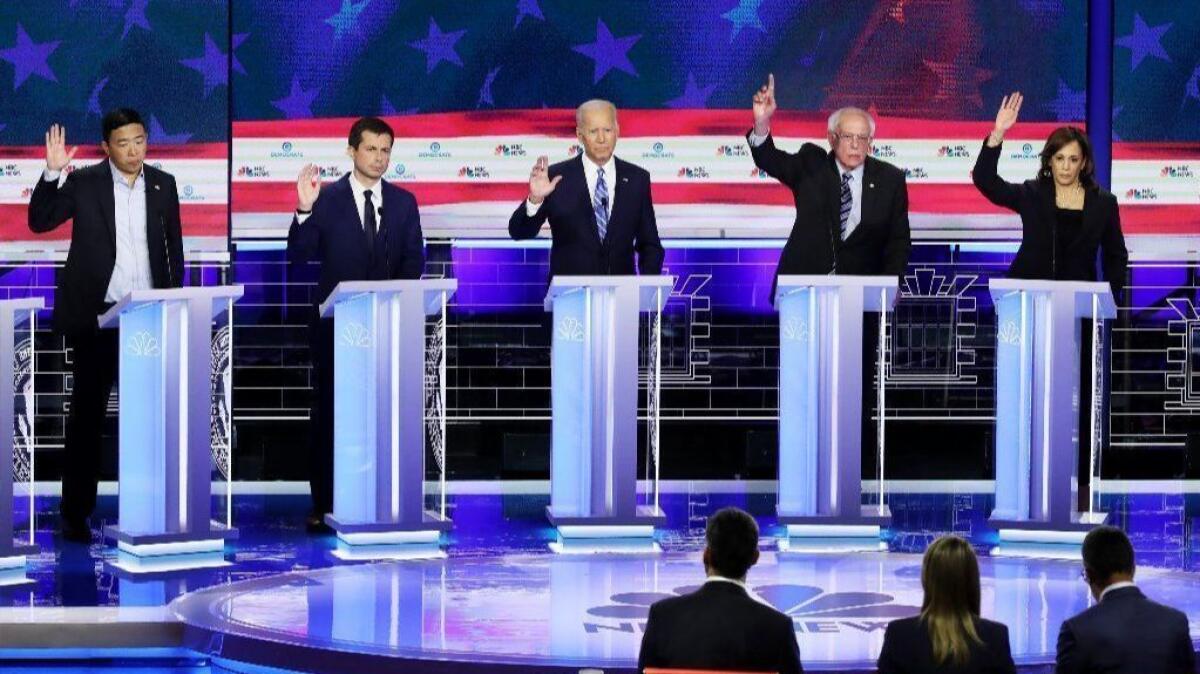Column: The 2020 race is officially on: Why both sides are capable of losing

- Share via
Reporting from Washington — Now that the 2020 presidential campaign is truly underway, here’s what we’ve learned so far.
President Trump is delivering the same angry, divisive message he used to mobilize his mostly white, mostly conservative voters four years ago. At his campaign’s kickoff rally, he told his followers in Orlando, Fla., that Democrats are “driven by hatred, prejudice and rage; they want to destroy you and destroy our country as we know it.” This time, Trump has the added advantages of incumbency, a unified Republican Party and a strong economy.
The Democrats are trying to reassemble the broad multiracial coalition that elected Barack Obama twice and almost elected Hillary Clinton. But as we saw in their debates last week, the scramble for primary voters is driving them leftward toward policy positions that could be trouble in the general election campaign — on healthcare and immigration, for example.
Trump’s divisiveness is a calculated, purposeful feature; it was key to his electoral college victory in 2016. Several teams of political scholars produced postmortems on that election and came to the same conclusion: Trump won because he seized control of the debate and hammered at issues that touched on race, ethnicity and national identity, including Mexican immigration and Islamic terrorism.
The fact that he has reopened the playbook this year is dispiriting but shouldn’t come as a surprise.
This time, however, Trump has a powerful new talking point: He’s presided over 2½ years of robust economic growth. The president is notorious for inventing his own facts, but on the economy the truth is mostly on his side.
Unemployment in May was 3.6%, the lowest rate in almost 51 years. Democrats argue that most of the credit should go to Obama for launching the recovery, but Obama isn’t on the ballot.
Normally, a first-term president with a growing economy should be able to coast into a second term. That’s how Ronald Reagan won in 1984, Bill Clinton in 1996 and Obama in 2012.
Not Trump. He’s so unpopular that he’s generated his own head winds. He’s the only president whose job approval has never reached 50% since the Gallup Poll began asking in 1938.
His personal unpopularity has produced a backlash against his positions, too.
After Trump began sweeping Republican primaries in 2016, backing for Obama’s healthcare law increased. So did support for offering undocumented immigrants a path to citizenship. And more Americans said the country hasn’t done enough to ensure equal rights for black citizens.
Most of the change in sentiment was among Democrats, who coalesced around the opposite to the president’s views.
In 2014, according to the Pew Research Center, 57% of white Democrats said they believed the “country needs to continue making changes to give blacks equal rights.” By 2017, the number had risen to 80%.
So the Democratic primary electorate is more liberal than it used to be — partly, it appears, because of that polarizing Trumplash. In 2009, 32% of Democrats described themselves as liberals; this year, it was 46%.
Those numbers help explain the noticeably progressive tone of the back-to-back Democratic debates. As my colleague Janet Hook pointed out, the candidates embraced positions well to the left of anything Obama espoused during his two terms, on a wide range of issues.
On healthcare, Bernie Sanders and Elizabeth Warren (and maybe Kamala Harris, who has muddled her position) said they favored abolishing private health insurance, an idea most voters oppose. Most other candidates, including Joe Biden, have said they would allow private insurance to compete with a government-run “public option” plan.
On immigration, all 10 candidates in Thursday’s debate said they would allow undocumented immigrants to enroll in their healthcare plans, something Obama never proposed.
Trump can be counted on to campaign gleefully against both of those positions, as well as the Green New Deal energy plan several candidates endorsed. He’s already denounced all the Democrats as “socialists,” including the ones who have explicitly denounced socialism.
“The most challenging thing in a presidential election is to be the party out of power when there’s a strong economy,” noted Lynn Vavreck, a UCLA scholar who co-authored one of the best of the 2016 postmortem studies, “Identity Crisis.”
Democrats “need to find an issue to focus on that voters will consider more important than the economy,” she told me. But it can’t just be opposition to Trump. “That was one of the lessons of Hillary Clinton’s campaign in 2016.”
Trump, on the other hand, has an opportunity he hasn’t yet seized.
“His best shot at winning is to highlight the economy,” Vavreck said. “He should probably run a different campaign in 2020 than he did in 2016.” There’s no sign of that yet.
Bottom line: This is an election both sides are fully capable of losing.
More to Read
Get the L.A. Times Politics newsletter
Deeply reported insights into legislation, politics and policy from Sacramento, Washington and beyond. In your inbox twice per week.
You may occasionally receive promotional content from the Los Angeles Times.











